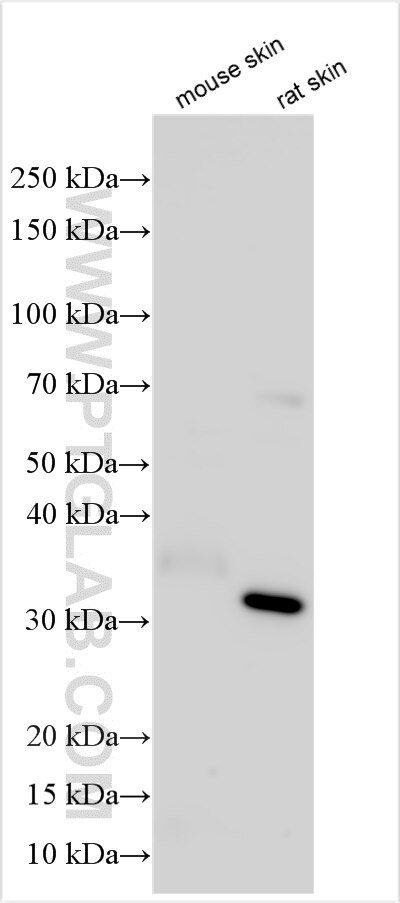Tested Applications
| Positive WB detected in | mouse skin tissue, rat skin tissue |
Recommended dilution
| Application | Dilution |
|---|---|
| Western Blot (WB) | WB : 1:1000-1:6000 |
| It is recommended that this reagent should be titrated in each testing system to obtain optimal results. | |
| Sample-dependent, Check data in validation data gallery. | |
Product Information
28136-1-AP targets Caspase 14 in WB, ELISA applications and shows reactivity with human, mouse, rat samples.
| Tested Reactivity | human, mouse, rat |
| Host / Isotype | Rabbit / IgG |
| Class | Polyclonal |
| Type | Antibody |
| Immunogen |
CatNo: Ag27242 Product name: Recombinant human CASP14 protein Source: e coli.-derived, PGEX-4T Tag: GST Domain: 1-242 aa of BC069541 Sequence: MSNPRSLEEEKYDMSGARLALILCVTKAREGSEEDLDALEHMFRQLRFESTMKRDPTAEQFQEELEKFQQAIDSREDPVSCAFVVLMAHGREGFLKGEDGEMVKLENLFEALNNKNCQALRAKPKVYIIQACRGEQRDPGETVGGDEIVMVIKDSPQTIPTYTDALHVYSTVEGYIAYRHDQKGSCFIQTLVDVFTKRKGHILELLTEVTRRMAEAELVQEGKARKTNPEIQSTLRKRLYLQ Predict reactive species |
| Full Name | caspase 14, apoptosis-related cysteine peptidase |
| Calculated Molecular Weight | 242 aa, 28 kDa |
| Observed Molecular Weight | 35 kDa |
| GenBank Accession Number | BC069541 |
| Gene Symbol | CASP14 |
| Gene ID (NCBI) | 23581 |
| RRID | AB_3086031 |
| Conjugate | Unconjugated |
| Form | Liquid |
| Purification Method | Antigen affinity purification |
| UNIPROT ID | P31944 |
| Storage Buffer | PBS with 0.02% sodium azide and 50% glycerol, pH 7.3. |
| Storage Conditions | Store at -20°C. Stable for one year after shipment. Aliquoting is unnecessary for -20oC storage. 20ul sizes contain 0.1% BSA. |
Background Information
Caspase14 belongs to the caspase family of cysteinyl aspartate-specific proteinases that frequently play a central role in apoptosis. Caspase14 exist as inactive proenzymes that undergo proteolytic processing to produce large and small subunits (p20 and p10) at Ile152/Lys153 residues, which is different to other caspases (Asp residue). Caspase14 plays a role in protein maturation of filaggrin, and possibly in DNA repair. Overexpression of Caspase14 has been detected in several of epithelial malignancies, indicating that Caspase14 could play a role in carcinogenesis and disease progression of cancers. Caspase14 can binds the apoptosis-inducing factor (AIF) indicating that caspase14 may be an anti-apoptotic protein. In the LADC specimens, two bands can be detected with MW of 35 kDa and 37 kDa which represent Caspase14 and the phosphorylated Caspase14(pCasp-14) respectively. (PMID:21567094, 12200134, 10203698, 17515931, 16061209). This antibody can recognise all the forms of Caspase14.
Protocols
| Product Specific Protocols | |
|---|---|
| WB protocol for Caspase 14 antibody 28136-1-AP | Download protocol |
| Standard Protocols | |
|---|---|
| Click here to view our Standard Protocols |




